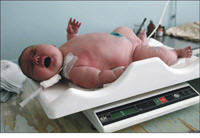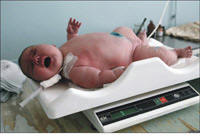
http://www.juventudrebelde.cu/cuba/2007-10-20/la-clamidia-una-infeccion-de-transmision-sexual-/
A sexually transmitted infection called chlamydia
One of every ten sexually active men is affected by Clamydia trachomatis, a microorganism responsible for infertility.
E-mail:
digital@jrebelde.cip.cu
October 20, 2007 - 00:00:23 GMT

A CubaNews translation. Edited by Walter Lippmann.
Unknown to many people, chlamydia is an often asymptomatic STD with a high incidence on male fertility
«Chlamydia??? What can give me that? Can it make me sterile!? Isn’t that a woman’s thing!?» were among the exclamations and doubts stated by most of the men that Sexo Sentido interviewed this week to have an idea of how much young people know about this infection.
Some had never heard of it, but others who had known nothing about its symptoms and consequences, were startled when alerted to its dangers.
According to recent studies, this «stealthy» disease –caused by a bacterium called Chlamydia trachomatis– which affects one of every ten sexually active men can lead to diminished fertility and, if left untreated, sterility.
Conducted by the hospital Juan Canalejo in Spain and presented this year in the annual meeting of the American Society of Reproductive Medicine, the research revealed this STD can make a man’s sperm defective by impairing its concentration and ability to move around.
Trials included the study of sperm from 193 men who had fertility treatment because their attempts to have children had repeatedly failed. Of them, 143 were infected with chlamydia.
Then, a new microscopic analysis technique helped the scientists discover that the level of DNA damage or fragmentation in their sperm was three times that of healthy men.
A four-month-long treatment with antibiotics followed by 95 of these patients corrected the said DNA problem in 36% of the cases. During that period, 13% of the couples achieved the longed-for pregnancy, and over 85% of them in the months following the end of the treatment.
A dangerous silence
Known as the «silent epidemic», chlamydia may go undetected, so the infected remain unaware of its presence, disregard safe sex, and spread it even further as a result.
According to the experts, this bacterial genus can cause scarring inside the reproductive organs of men and women alike. It is transmitted mainly by means of sexual intercourse or by contact of a person’s mouth or eyes with infected mucus found in the reproductive, urinary or anal apparatus.
In the case of women, chlamydia can cause cervical infection, damage the Fallopian tubes, and even prevent the ovules from reaching the uterus.
In men, as recent research has revealed, it can cause swelling of the testicles or the scrotum. In either case its incidence is directly related to the future quality and mobility of a man’s spermatozoa. As it spreads to the whole genital tract, it tampers with the successful course of fertilization in both sexes.
A major problem is that the male population is chlamydia’s natural reservoir. However, asymptomatic as it is, men seldom keep themselves «under control» and contribute to propagation.
Some men have symptoms like an unusual discharge of a purulent, light-colored viscous discharge, a painful or burning sensation when urinating, and urethritis (inflammation of the urethra).
Moreover, anal penetration can cause rectal infection, which causes pain, discharge or bleeding.
Chlamydia has also been found in the throat of those who have had oral sex with an infected person, as well as in the epididymis, where it destroys the spermatic duct system, albeit very few cases have been reported.
Data has it that three of every four infected women and nearly half the infected men are asymptomatic. Otherwise the symptoms appear between one and three weeks after the infection.
The International Federation of Obstetrics and Gynecology classifies chlamydia as a sexually transmitted infection conducive to infertility. About 2.8 million cases of chlamydia infection occur in the United States each year, and twice as many in Latin America, since the vast majority of people in developing countries have no access to methods of contraception such as condoms, the most reliable way of decreasing the risk of contracting STDs.
The higher the number of sex partners, the higher the risk of getting infected. Sexually active teenagers and youths are more exposed because their cervix is yet to be fully developed.
Danger for two
Most young interviewees were unaware of the danger, as they believed that the STDs can cause infertility only in women. Hence the alert issued by the experts to young people, who are not only more at risk from infection –given the existing levels of promiscuity– but also from the physical and psychological consequences of not being able to have children when they want to.
If not treated, chlamydia can spread and cause reproductive and health problems with serious short- and long-term effects.
There are laboratory assays to detect chlamydia. Some include urine testing; others may be performed on swab specimens collected from the cervix (women) or urethra (men). The infection can be effectively treated with antibiotics once it is detected and cured without any major hitches, all the more reason to see a doctor on a regular basis to be sure you’re not infected.
Those who are, however, must refrain from having sex until both members of the couple are treated and declared cured.
It’s all a matter of taking care of your partner and understand that men and women are equally bound to prevent in good time any devil-may-care conduct from dashing the wonderful joy of parenthood.
---ooOoo---
http://www.juventudrebelde.cu/cuba/2007-10-20/pregunte-sin-pena/
Ask Up Front
By: Mariela Rodríguez Méndez*
E-mail: digital@jrebelde.cip.cu
October 20, 2007 - 00:00:43 GMT
R.R: I have got a herpes simplex virus type 1 right after I shaved my mons pubis. Now it always comes up at the beginning and end of my periods. I read an article in your section where you link shaving and sexually transmitted infections.
If shaving leaves you with scars and then you make love with a person infected with a sexually transmitted infection (STD), those little wounds are more likely to become an open door to infectious agents like HIV, gonococcus and hepatitis B viruses, among others, carried by the semen or other genital fluids. The risk is just as high in the case of viruses transmitted by direct contact, such as herpes or papilloma. Using a razor blade with traces of infected blood might pass on the virus if you cut yourself, however lightly, while the infectious pathogen is still active, but this is less likely, though.
Even if you got the virus by shaving, the lesions would have taken between two and twenty days to incubate. You were most probably playing host to the virus before the symptoms appeared, which can happen sometimes as it can remain latent for an indefinite time without manifesting itself.
A rash caused by shaving can very well be the trigger which sparks off the viral lesions. It can also reactivate from menstruation, excessive heat, illness, stress, fatigue and even friction during sex.
Genital herpes is caused by two viruses: herpes simplex virus type 1 (HSV-1) and type 2 (HSV-2). The former is the cause of oral herpes –commonly called cold sores– transmitted by contact with a herpetic sore (kissing, touching and sharing drinking glasses or pieces of cutlery), but it can also be spread to the genitals via oral sex with an infected person. In other words, both strains can be transmitted by sexual contact.
* Master’s in Psychology and counselor in STDs and HIV/AIDS.
---ooOoo---
http://www.juventudrebelde.cu/cuba/2007-10-20/sabias-que/
Did you know that...
E-mail: digital@jrebelde.cip.cu
October 20, 2007 - 00:00:43 GMT
 A Russian girl weighted
7,75 kilograms at birth, more than twice the average of a newborn child.
Nadia, the «giant» baby bound to be registered as one of the biggest
babies in history, was born by cesarean section.
A Russian girl weighted
7,75 kilograms at birth, more than twice the average of a newborn child.
Nadia, the «giant» baby bound to be registered as one of the biggest
babies in history, was born by cesarean section.
Last January, a Brazilian mother gave birth to a 7,73-kg baby, the biggest in Brazil yet, according to gynecology authorities in that country.
Among the heaviest newborns ever recorded are an Italian boy born in 1955 who weighed 10,2 kilograms and an American baby who tipped the scale till the 10,8-kilogram mark, although he only lived for 11 hours.
WHO statistics show that a newborn’s average weight is 3,2 kilograms. Therefore, Nadia has gone down in history as another curiosity of human reproduction, not unlike oddities such as multiple births and «impossible» pregnancies, which testify to how complex and incredible our body can be.
---ooOoo---
La clamidia: una
infección
de transmisión sexual
http://www.juventudrebelde.cu/cuba/2007-10-20/la-clamidia-una-infeccion-de-transmision-sexual-/
 Desconocida
por no pocos jóvenes, y muchas veces asintomática, la clamidia
es una ITS que tiene una incidencia elevada en la fertilidad de
los varones
Desconocida
por no pocos jóvenes, y muchas veces asintomática, la clamidia
es una ITS que tiene una incidencia elevada en la fertilidad de
los varones
¿¡CLAMIDIA!? ¿Qué provoca eso? ¿Puede hacerme infértil? ¿Eso no es de las mujeres? Estas fueron exclamaciones e interrogantes que plantearon la mayoría de los varones encuestados esta semana por Sexo Sentido en busca de un acercamiento a cuánto saben los jóvenes sobre la llamada clamidia.
Para algunos resultó extraño el nombre. Otros lo habían oído antes, pero no conocían ni sus síntomas, ni sus consecuencias. Y al comentarles sobre la influencia que tiene en la fertilidad masculina, los sobresaltos no faltaron.
Aunque «silenciosa», esta enfermedad, causada por la bacteria chlamydia trachomatis, afecta a uno de cada diez hombres sexualmente activos, y según investigaciones recientes puede provocar una infertilidad que, si no se trata, puede causar esterilidad.
El estudio realizado en el hospital Juan Canalejo, en España, y presentado este año en la reunión anual de la Sociedad Estadounidense de Medicina Reproductiva, reveló que esta ITS afecta la concentración de los espermatozoides, su capacidad para desplazarse y puede generar otros defectos en los mismos.
En la pesquisa se analizó el esperma de 193 hombres que se sometieron a tratamientos de fertilidad porque no lograban tener hijos. De ellos 143 estaban contagiados con clamidia.
Luego, por medio de una nueva técnica de análisis microscópico, los científicos descubrieron que el nivel de los daños, o fragmentación del ADN en su esperma, era tres veces más alta que en hombres sanos.
Se trató a 95 de los pacientes con antibióticos, y se revirtieron los daños en el ADN del esperma en un 36 por ciento en un plazo de cuatro meses.
Durante ese período, el 13 por ciento de las parejas logró el embarazo tan deseado y después de terminar el tratamiento más del 85 por ciento logró concebir.
Peligroso silencio
Al ser una infección «silente», como la llaman los especialistas, en la mayoría de los casos, tanto hombres como mujeres ignoran su presencia y continúan la cadena de transmisión al tener relaciones sexuales desprotegidas, sin el uso del preservativo.
Según indican los expertos, este microorganismo destruye las células del aparato reproductor femenino y masculino, y se contagia principalmente a través de las relaciones sexuales, o por el contacto de la boca o los ojos con mucosa infectada del aparato reproductivo, urinario o anal.
En las mujeres puede ocasionar una inflamación en el cuello del útero, dañar las trompas de Falopio, dificultar su funcionamiento, e incluso puede bloquear el paso de los óvulos hacia el útero.
Las nuevas investigaciones revelaron que en el caso de los hombres, esta enfermedad puede causar inflamación de los testículos o del escroto, y en ambos casos su incidencia está directamente relacionada con la calidad futura y movilidad de los espermatozoides.
Los especialistas la describen como una «inflamación silenciosa» de todo el tracto genital, generando un ambiente no propicio para el desa-rrollo exitoso de la fecundación, o para el normal funcionamiento de estos órganos, tanto en los hombres como en las mujeres.
El principal problema es que la población masculina es el reservorio natural de esta bacteria, pero muy pocas veces provoca una reacción en ellos, lo que hace que «no se controlen» y se contribuye a la propagación.
Solo en algunos varones la clamidia origina secreciones transparentes o cremosas, dolor o sensación de ardor al orinar y uretritis (inflamación del conducto uretral).
Además las personas que practican la penetración anal, pueden contraer la infección clamidial en el recto, que provoca dolor rectal, secreciones o sangrado.
La clamidia puede hallarse también en la garganta de quienes han tenido relaciones sexuales orales con una pareja infectada.
En ocasiones ocurre que la bacteria se aloja en el epidídimo, destruyendo los canales por los que pasan los espermios, pero estos casos en hombres son más aislados.
Las estadísticas revelan que tres de cada cuatro mujeres infectadas y cerca de la mitad de hombres no presentan síntomas, y si aparecieran, generalmente sucede entre una y tres semanas después del contagio.
Según reportes de la Federación Internacional de Ginecología y Obstetricia la tasa de incidencia de las ITS y dentro de ellas la clamidia se convierte en una de las causas de infertilidad. En países como Estados Unidos se estima que más de dos millones de personas resultan infectados cada año.
En América Latina el número se duplica. Una parte importante de la población de los países subdesarrollados no tiene acceso a los métodos anticonceptivos, especialmente el condón, que es la única barrera que podría evitar el contagio.
Entre mayor número de parejas sexuales tenga la persona, mayor es el riesgo de infección. Las adolescentes y las jóvenes que son sexualmente activas están más expuestas a la infección, pues su cuello uterino no se ha desarrollado completamente.
Un peligro para dos
Al decir de la mayoría de los jóvenes entrevistados, las ITS producen daños en la fertilidad solo de las mujeres. Ellos no reconocen en su organismo el peligro latente al contraer tales enfermedades.
De ahí que muchos expertos lanzan hoy una alerta a la población joven, que además de ser la más propensa a contraerla —dados los niveles de promiscuidad—, también se exponen a consecuencias físicas y psicológicas al no poder concebir cuando lo deseen.
Si la clamidia no es tratada, la infección puede avanzar y causar graves problemas reproductivos y de salud con consecuencias a corto y largo plazos.
En el mundo existen pruebas de laboratorio para diagnosticar la clamidia. Algunas de ellas pueden realizarse en la orina, mientras que otras pruebas requieren de una muestra obtenida directamente del pene o el cuello del útero.
La clamidia puede ser fácilmente tratada y curada con antibióticos, y si se detecta a tiempo puede pasar sin complicaciones. Por ello es necesario realizarse exámenes periódicos que descarten la existencia de ITS.
Para quienes ya la tienen, se debe mantener un período de abstención hasta que ambos miembros se sometan al tratamiento y se verifique la desaparición de la enfermedad.
Se trata de cuidar a la pareja, de entender que hombres y mujeres tienen iguales deberes de evitar a tiempo que conductas irresponsables frustren para ellos la maravilla de ser padres.
Pregunte sin pena
Si nos quedan cicatrices después de afeitarnos y hacemos el amor con quien padezca una Infección de Transmisión Sexual (ITS) aumentan las probabilidades de que las pequeñas heridas constituyan puertas de entrada fácil de agentes infecciosos como el VIH, gonococo y el virus de la hepatitis B, entre otros, contenidos en el semen o líquidos genitales. También es más fácil para aquellos transmisibles por contacto directo con las lesiones como pudieran ser el mismo herpes o el papiloma. La cuchilla ensangrentada y contagiada puede infectarnos si la usamos y nos cortamos mientras los agentes infecciosos estén activos o vivos. Esto último es menos posible.
Aunque hubieses adquirido el virus a partir del rasurado, las lesiones habrían tardado entre dos y 20 días en incubarse. Lo más probable es que dicho virus se haya hospedado en tu cuerpo antes, sin generar sus típicas manifestaciones. En ocasiones puede mantenerse por tiempo indefinido en nuestro organismo como hospedero, sin exteriorizarse.
El rasurado, en caso de que se haya irritado la piel, es uno de los detonantes de las lesiones virales. También aceleran el brote la menstruación, el calor excesivo, las enfermedades, el malestar emocional, la fatiga e inclusive la fricción de las relaciones sexuales.
El herpes genital es causado por dos virus llamados virus herpes simple tipo 1 (VHS-1) y virus herpes simple tipo 2 (VHS-2). El VHS-1, responsable del herpes labial o boqueras comunes, se transmite a través de secreciones orales durante los besos y al comer o beber con utensilios contaminados. Pero también puede producir herpes genital a través del sexo oral con alguien infectado, por lo que ambas cepas del virus pueden transmitirse sexualmente.
* Máster en Psicología y consejera en ITS y VIH/Sida
Sabías que...
 Una
niña rusa pesó 7,75 kilogramos, más del doble del peso medio de
los recién nacidos. Conocida ahora como Nadia, la bebé «gigante»,
la pequeña nació mediante cesárea, y posiblemente se reconozca
como una de las bebés más grandes de la historia.
Una
niña rusa pesó 7,75 kilogramos, más del doble del peso medio de
los recién nacidos. Conocida ahora como Nadia, la bebé «gigante»,
la pequeña nació mediante cesárea, y posiblemente se reconozca
como una de las bebés más grandes de la historia.En el pasado mes de enero, una madre brasileña dio a luz a un bebé que pesó 7,73 kilogramos, el mayor niño nacido en Brasil según la Asociación Brasileña de Ginecología.
Entre los recién nacidos más pesados de los que se tiene constancia, se encuentra un niño italiano que nació en 1955 con un peso de 10,2 kilos y un bebé estadounidense que pesó 10,8 kilogramos, aunque murió 11 horas después de nacer.
Según la Organización Mundial de la Salud, el peso medio de los recién nacidos es de 3,2 kilos. Esta se incluye dentro de las curiosidades que a lo largo de los siglos ha tenido la reproducción humana, que junto a los partos múltiples y embarazos «imposibles» dan fe de lo complejo e increíble que puede ser el organismo.